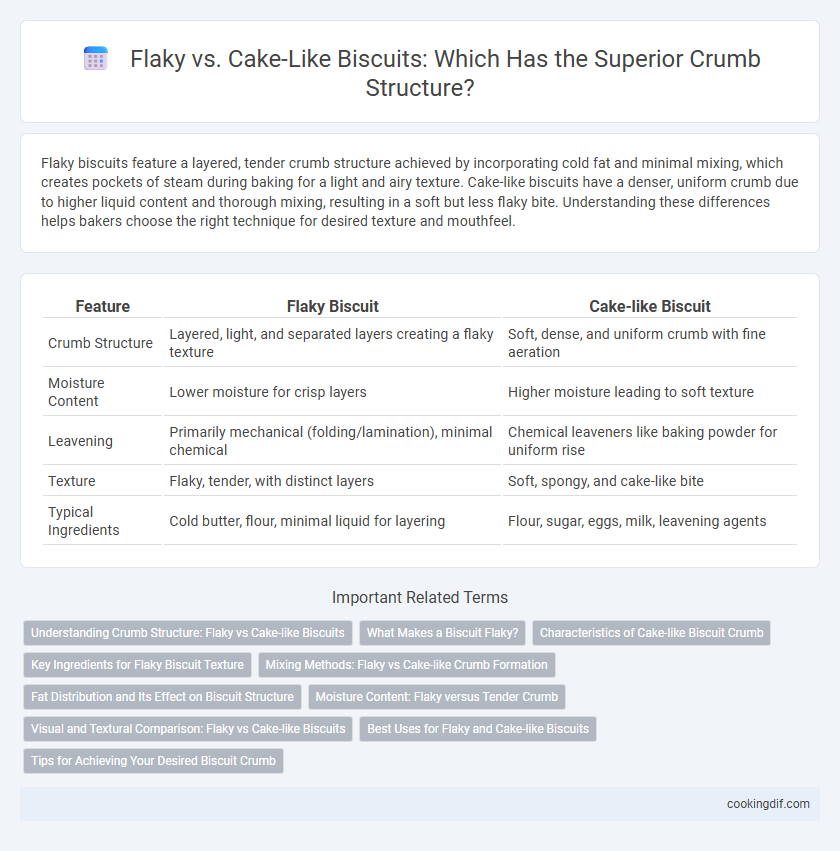Flaky biscuits feature a layered, tender crumb structure achieved by incorporating cold fat and minimal mixing, which creates pockets of steam during baking for a light and airy texture. Cake-like biscuits have a denser, uniform crumb due to higher liquid content and thorough mixing, resulting in a soft but less flaky bite. Understanding these differences helps bakers choose the right technique for desired texture and mouthfeel.
Table of Comparison
| Feature | Flaky Biscuit | Cake-like Biscuit |
|---|---|---|
| Crumb Structure | Layered, light, and separated layers creating a flaky texture | Soft, dense, and uniform crumb with fine aeration |
| Moisture Content | Lower moisture for crisp layers | Higher moisture leading to soft texture |
| Leavening | Primarily mechanical (folding/lamination), minimal chemical | Chemical leaveners like baking powder for uniform rise |
| Texture | Flaky, tender, with distinct layers | Soft, spongy, and cake-like bite |
| Typical Ingredients | Cold butter, flour, minimal liquid for layering | Flour, sugar, eggs, milk, leavening agents |
Understanding Crumb Structure: Flaky vs Cake-like Biscuits
Flaky biscuits feature a layered, tender crumb structure created by folding cold butter into the dough, which produces distinct, thin layers that separate during baking. Cake-like biscuits exhibit a finer, softer crumb with a more uniform texture, achieved by incorporating chemical leaveners and minimal handling to promote a light, airy interior. Understanding these crumb structures helps bakers tailor texture preferences, with flaky biscuits offering a crisp bite and cake-like biscuits providing a moist, tender mouthfeel.
What Makes a Biscuit Flaky?
Flaky biscuits achieve their characteristic crumb structure through layers formed by cold fat, such as butter or shortening, which creates steam pockets during baking, causing the dough to separate and rise. The lamination process, involving folding and rolling the dough, is essential for distinct layers and a tender, crisp texture. In contrast, cake-like biscuits have a uniform crumb, relying more on chemical leaveners like baking powder and a higher moisture content for a soft, tender bite.
Characteristics of Cake-like Biscuit Crumb
Cake-like biscuit crumb exhibits a soft, tender texture with fine, even air pockets generated by chemical leavening agents such as baking powder. This crumb structure results from higher moisture content and the use of sugar, which tenderizes the dough and contributes to a delicate, moist mouthfeel. Unlike flaky biscuits, cake-like biscuits have a uniform crumb without distinct layers, providing a cohesive, cake-like bite.
Key Ingredients for Flaky Biscuit Texture
Flaky biscuit texture relies heavily on cold, solid fats such as butter or shortening to create distinct layers by melting and releasing steam during baking, which separates the dough into thin, crisp sheets. The use of minimal liquid and careful mixing preserves these fat layers, preventing gluten development that leads to tenderness over flakiness. In contrast, cake-like biscuits contain higher liquid content and chemical leaveners like baking powder that promote a softer crumb by encouraging more uniform air pockets rather than distinct layers.
Mixing Methods: Flaky vs Cake-like Crumb Formation
Flaky biscuits achieve their distinct layered crumb structure through minimal mixing and the incorporation of cold fat, which creates steam pockets that separate dough layers during baking. In contrast, cake-like biscuits rely on thorough mixing to develop a tender, uniform crumb by evenly distributing leavening agents and creating smaller, consistent air bubbles. Understanding these mixing methods is essential for controlling texture and achieving the desired biscuit crumb, whether flaky or cake-like.
Fat Distribution and Its Effect on Biscuit Structure
Flaky biscuits achieve their characteristic layered crumb structure through the strategic distribution of solid fat, such as cold butter or shortening, which creates distinct layers as the fat melts during baking. In contrast, cake-like biscuits incorporate fat more uniformly into the batter, often using melted or creamed fats, resulting in a finer, softer crumb with a tender texture. The differing fat distribution methods directly influence moisture retention, air incorporation, and crumb formation, defining the biscuit's overall structure and mouthfeel.
Moisture Content: Flaky versus Tender Crumb
Flaky biscuits exhibit a lower moisture content, resulting in distinct, layered crumb structures with crisp edges due to steam pockets formed during baking. Cake-like biscuits contain higher moisture levels, producing a tender crumb with a soft, uniform texture and less defined layers. The moisture differential directly influences the biscuit's crumb integrity and mouthfeel, distinguishing flaky biscuits from their cake-like counterparts.
Visual and Textural Comparison: Flaky vs Cake-like Biscuits
Flaky biscuits exhibit multiple delicate layers with a golden-brown, crisp exterior and a tender interior, creating a light, airy texture that easily separates with each bite. Cake-like biscuits have a denser, more uniform crumb, characterized by a soft, moist appearance and spongy texture that holds together firmly without visible layering. Visually, flaky biscuits reveal distinct lamination, while cake-like biscuits show a smooth, fine crumb structure; texturally, flaky biscuits offer a crisp flake contrasted by the moist, elastic chew of cake-like varieties.
Best Uses for Flaky and Cake-like Biscuits
Flaky biscuits feature distinct layers and a tender, buttery texture ideal for savory applications like breakfast sandwiches and as a side for hearty stews, complementing rich and robust flavors. Cake-like biscuits offer a softer, denser crumb with a sweetness that pairs well with jams, honey, or as a base for desserts, making them perfect for tea-time treats and sweeter dishes. Choosing between flaky or cake-like biscuits depends on desired crumb structure and flavor profile to best suit the intended culinary purpose.
Tips for Achieving Your Desired Biscuit Crumb
Flaky biscuits feature distinct layers achieved by incorporating cold butter and minimal handling to create steam pockets during baking, resulting in a tender, crisp crumb. Cake-like biscuits rely on chemical leaveners like baking powder and gentle mixing to produce a soft, tender crumb with a uniform texture. To achieve your desired biscuit crumb, chill ingredients thoroughly for flakiness or mix just until combined for cake-like tenderness, and avoid overworking the dough to prevent toughness.
Flaky biscuit vs Cake-like biscuit for crumb structure Infographic

 cookingdif.com
cookingdif.com